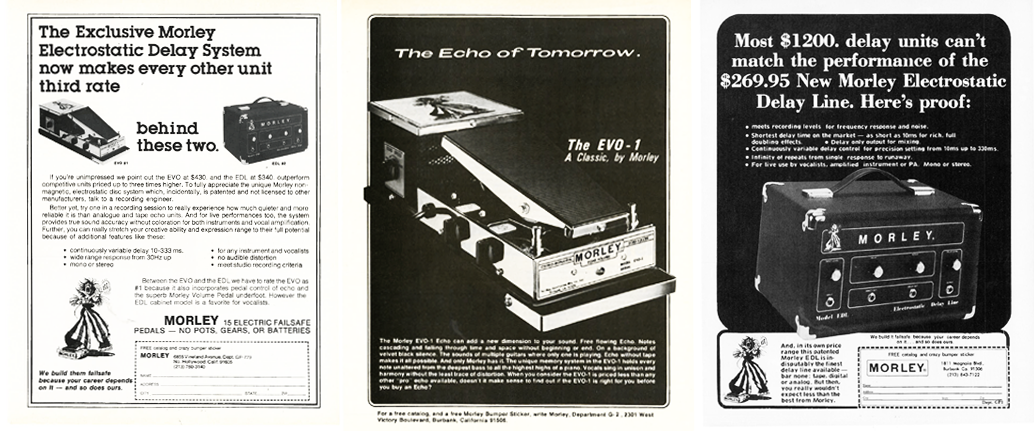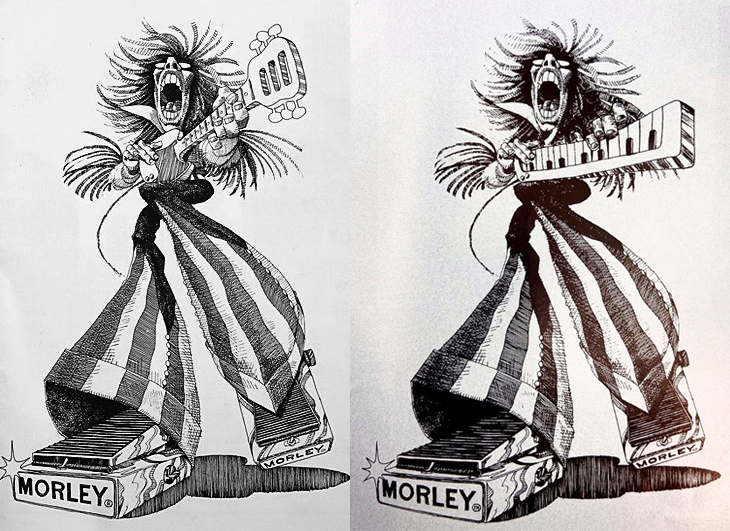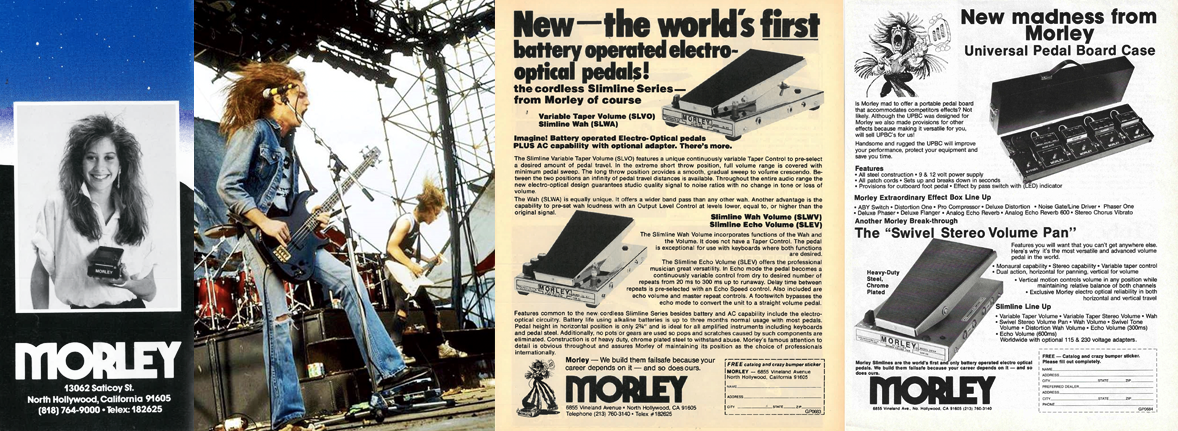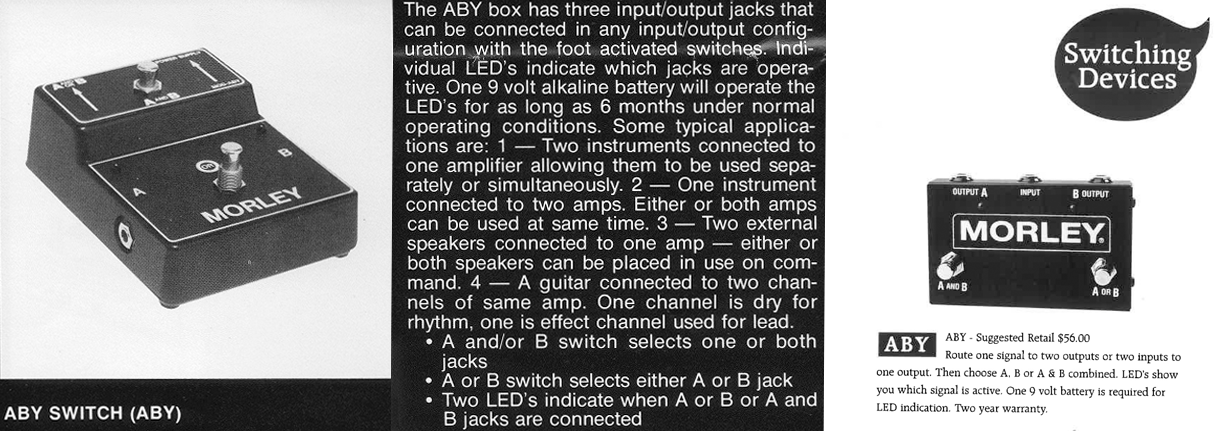History of Morley Pedals
The Beginning
Morley® was founded in the late 60’s by two brothers Marv and Ray Lubow, but the story of how it all came to be dates back to 1946. Marv and Ray had both served in the Army during WWII (Ray served in the Army Signal Corps) and after being discharged from the service they moved from New York City to sunny Los Angeles. After being left unsatisfied from a series of different gigs the brothers decided to start their own business. Little did they know that this risky decision would not only change their lives, but also help shape the history of Rock n’ Roll.
Ray was a bright young electrician that could fix anything and Marv was driven to be his own boss. Together they formed Tel-Ray Electronics specializing in Television and Radio repair. In the late 40’s Television was just beginning to take over the world. TV repair services were pretty much non-existent and since Ray knew how to fix them, it opened up a huge market for them. Business was booming and they were soon able to purchase a fleet of repair trucks. They also purchased their own building which resided at 81st & Avalon in Watts, Los Angeles.

Picture of the Tel-Ray Morley staff circa early 70’s. Marv Lubow is 5th from left, Ray Lubow is sitting. Photo Credit: The Lubow Family
The 1950’s Venture Into Audio
Marv and Ray’s venture into the audio world began as distributors for JBL. At the height of their TV and Radio repair business it was a no-brainer to expand into the growing audio market. Despite their success, Ray was still looking for a challenge and something beyond just repairing Televisions and Radios. It was during this time in the 50’s that Ray found his calling as an inventor.
One of his first audio devices was a crudely put together stereo, which involved two stripped down JBL speakers and a garden hose. With two speakers being driven from a single source Ray had claimed to create “live sound” as stereo wasn’t officially a term then. They pitched the idea to a couple different companies including Thomas Organ Co. and eventually sold 50 pieces to Precision Radiation Instruments Inc.
While the brothers had successfully brought this device to market, Ray had become bored with it and wanted to do more. The length of the garden hose had produced a short 50 millisecond delay, which Ray liked and it inspired him to create his next invention…
The Oil Can
On June 30th 1959, Ray Lubow was granted a patent for an electro-static delay apparatus, which is known today as the Oil Can Delay. It’s nickname came from the device’s enclosure along with the fluid contained within it. This device could emulate the sound of a vibrato, a rotary speaker or create a wobbly slapback delay. Ray knew that he finally had something, but it wouldn’t be until the mid 60’s that the device would hit the market.

The first use of Delay as an effect was pioneered by legendary Guitarist and Inventor Les Paul. It was achieved by using a Tape machine that would record the audio signal and then play it back. Tape Delay is still desired today due to it’s warm analog character, but the early units were high maintenance. Ray claimed his design solved the issues commonly faced with Tape.
At the heart of the Oil Can is an aluminum disc that’s anodized on one side. Since one side was anodized and the other was bare aluminum it acted like a capacitor. The disc was hooked up to a motor and was lubricated by a semi-conductive dielectric fluid. Two specially designed rubber pads would splash the fluid onto the disc and then remove it as it moved. This allowed the signal to be erased on demand and prevent the signal from continuously oscillating. The motor then controlled the speed of the delay.

The Oil Can produced a unique “warble” character and would be released in many different versions. According to Ray they continued to manufacture these devices up until 1989, but they were mainly produced in the 60’s and 70’s. The EVO-1 Echo Volume is hailed as the most advanced version.
 Pictured Center is the earliest treadle controlled Oil Can device. Later versions would use an optical circuit instead of a potentiometer. Photo Credit Reverb.com
Pictured Center is the earliest treadle controlled Oil Can device. Later versions would use an optical circuit instead of a potentiometer. Photo Credit Reverb.com
The 1960’s Watts Riots
In August of 1965, a dark chapter in American History occurred… The Watts riots. Marv had noticed that traffic was unusually quiet on Avalon. After he went outside and saw no traffic and a giant plume of smoke from the Imperial Highway he knew something was wrong and sent all employees home.
After 7 days when things seemed to calm down Marv and Ray along with a few employees went back to retrieve what they could. They found that the building had almost been set on fire, but was put out by the fire department. Fortunately, they had sent their fleet of trucks home with their employees and were able to recover valuable files. Along with insurance they were able to get back into business, but their dreams almost went up in smoke.

Marv and Ray moved their business to Burbank and while re-establishing themselves they also faced a new problem. The Television and Radio repair business had peaked. Ray suggested that they setup a lab where they could do Research & Design and become a manufacturer. After all, Ray had successfully secured a patent and knew if they could create more it would secure their future.
The Morley Name is Born
Ray and Marv had met Leo Fender at a trade show and decided to travel across town to pitch him on the Oil Can as a Vibrato. At the time Leo was buying the Vibratone from Leslie and the brothers thought that their device would be more appealing to him since it was smaller. Leo was fascinated with the device and started ordering around 100 units per month for his amplifiers. The brothers then expanded their OEM business to a number a different amplifier companies.
Marv and Ray had also licensed Thomas Organ Co. to manufacture their own version, but their prototypes weren’t able to eliminate the “tail” of the delay and they never went into production. Chief Engineer Stan Cutler became increasingly frustrated with the project, mostly from Marv and Ray’s lack of help and it was abandoned.
Eventually Marv and Ray became tired of the OEM business and wanted to start selling their devices under their own brand name. Tasked with coming up with a brand name, the idea popped into Ray’s head while him and Marv we’re in the parking lot of a restaurant. It was a playful joke on their competitor Leslie… “Why settle for less with a Leslie when you can get more with Morley®”
Now the brothers just needed a logo to launch their new brand. Marv was a big fan of a local cartoonist/satirist and contracted him to create a mascot. After three renditions the iconic Morley Man was chosen.
 The Original Morley Man (Left) and the Keyboard Morley Man (Right)
The Original Morley Man (Left) and the Keyboard Morley Man (Right)
The 1970’s Chrome Era
Ray then began tinkering with many different effects including the Wah pedal. The brothers knew that they’d have to expand beyond their delay unit to be successful. Many effects were limited to the technology at the time and a common problem with Wah pedals was potentiometer failure. Ray came up with an electro-optical design that solved this issue and by doing so introduced another revolutionary piece of technology to the effects world.
 Various Morley® Advertisements through the 70’s placed in Guitar Player Magazine.
Various Morley® Advertisements through the 70’s placed in Guitar Player Magazine.
In the late 60’s Fuzz and Wah were some of the most popular Guitar effects, made famous by players like Jimi Hendrix and Eric Clapton. This inspired Ray to create the most iconic Morley® effect next to the Oil Can… The Power Wah Fuzz. It used Darlington MPSA12 Transistors that delivered a monstrous ripped speaker Fuzz tone and when combined with it’s wide ranged optical Wah would let out a ferocious roar. This would go on to be famously used by Cliff Burton of Metallica.

For a couple of years during the 70’s Morley® was known as the industry standard for their quality of effects. In advertisements the motto was “We build them failsafe because your career depends on it and so does ours!” Many notable musicians at the time had used a Morley® at one point or another including David Gilmore, Geddy Lee, Alex Lifeson, Jerry Garcia and Lee Ritenour. Photo Credit Crimo Media
 Other notable effects made during this era. The Pro Flanger (Left) is regarded today as one of the best Flangers of all time by Andy Martin. The Bigfoot Power Amp was the first ever pedal amp and packed a whopping 50 watts of solid state power! The Die Cast Series (Right) featured many great effects including the first ABY and very likely coined the term ABY.
Other notable effects made during this era. The Pro Flanger (Left) is regarded today as one of the best Flangers of all time by Andy Martin. The Bigfoot Power Amp was the first ever pedal amp and packed a whopping 50 watts of solid state power! The Die Cast Series (Right) featured many great effects including the first ABY and very likely coined the term ABY.
The 1980’s Slimline Era
While Chrome was king in the 70’s the 80’s would send the effects pedal world into a radical change. This period proved challenging not only for the Lubow brothers, but also for other notable brands. Many either sold or went out of business. Japanese effects such as BOSS were dominating the market and new technology was putting session musicians out of work. Despite these challenges many agree that the 80’s is considered the pinnacle of the Electric Guitar.
The giant chrome enclosures were soon discontinued and replaced with the Slimline and Black Gold series. The primary change to the design was the height of the bottom enclosure. This greatly helped with portability. Still, musicians were asking for smaller pedals and Ray came up with the Compact series which utilized a clever internal slide pot instead of the famed optics. The internal design helped prevent dirt and other debris from getting inside and helped reduce costs so that they could remain competitive. These are considered the first “Mini” sized Wah and Volume pedals to hit the market.
 Bass Legend Cliff Burton (Second to Left) playing a Morley® on stage. Cliff switched between a Power Wah Boost and a Power Wah Fuzz. Photo Credit: Metallica
Bass Legend Cliff Burton (Second to Left) playing a Morley® on stage. Cliff switched between a Power Wah Boost and a Power Wah Fuzz. Photo Credit: Metallica
Ray and Marv produced many inventive effects through 1989 when Morley® was acquired by Sound Enhancement Products. The brothers had wanted to retire at this point as they were now approaching their 70’s and felt the time was right to hang up the cleats. A decade later Ray passed away from prostate cancer in 2002 and Marv passed away in 2010. Today they are survived by their family and the legacy of Morley®.
The 1990’s Sound Enhancement Era
The origins of Sound Enhancement Products started at the Hammond Organ Company, where spring reverb was developed into a popular effect. The names changed from Hammond, Accutronics, Gibbs, OC Electronics, Sound Enhancements Inc., Sound Enhancement Products and ultimately Sound Enhancement LLC. In 1989 the Morley® trade name was acquired from Tel-Ray Electronics in North Hollywood, CA. This is where engineer Scott Flesher and Sales / Marketing Manager Bill Wenzloff enter into Morley’s history through current day.
 Scott Flesher (left), Bill Wenzloff (center) with the late great Bassist Randy Coven.
Scott Flesher (left), Bill Wenzloff (center) with the late great Bassist Randy Coven.
 The beloved Morley Man also went through a makeover in the 90’s. The Wasp version featured on the right was briefly used to promote the newly invented WAH-SP or “Wah, Switchless Pedal.”
The beloved Morley Man also went through a makeover in the 90’s. The Wasp version featured on the right was briefly used to promote the newly invented WAH-SP or “Wah, Switchless Pedal.”
In January 1990, Accutronics, Inc. moved its Reverb and Morley® divisions into a separate facility in Cary, IL. Randy Wright was made General Manager and eventually became company owner in from 2005 to 2014. In May 1991, the Reverb and Morley® divisions of Accutronics® were incorporated into the entity, Sound Enhancements, Inc.

Morley® Manufacturing Facility circa 2005. General Manager / Owner Randy Wright.
Scott Flesher was tasked with redesigning their entire line of effects. The 70’s optical effects used a 387 “Pilot” light bulb for the heart of their circuits, but new LED technology proved to be much more reliable. The new lineup was released in 1992 along with the revised ABY Switching pedal. Little did we know that this redesign would go on to become one of the most popular utility effects of all-time.
 1980’s Die Cast Series ABY (Left) and the redesigned 1992 ABY (Right)
1980’s Die Cast Series ABY (Left) and the redesigned 1992 ABY (Right)
Bill Wenzloff was tasked with managing sales and growing artist relations. Bill was a big fan of Guitar Virtuoso Steve Vai and after meeting him at The NAMM Show pitched him the idea of his own signature Wah pedal. Steve worked with Scott and Bill on a prototype for a lengthy period of almost two years, but in the end it paid off. The Bad Horsie® was released in 1996 and it would go on to become one of the best-selling pedals for the company and a staple for many professionals. Morley® would later release The Little Alligator Volume pedal with Steve.

Various Morley Ads with Steve Vai featured in Guitar Player and Guitar World Magazines.
 Morley’s featured artists during this period (L to R): Testament, Jason Becker, Randy Coven, Zakk Wylde, Jim Martin, Al DiMeola, Kiko Loureiro, Mark Tremonti, Steve Vai, George Lynch, T.M. Stevens and Tommy Bolan.
Morley’s featured artists during this period (L to R): Testament, Jason Becker, Randy Coven, Zakk Wylde, Jim Martin, Al DiMeola, Kiko Loureiro, Mark Tremonti, Steve Vai, George Lynch, T.M. Stevens and Tommy Bolan.
In 1999, Sound Enhancements Inc. became a member of the Stainless Industrial Company. Later in 2001, Sound Enhancements, Inc. acquired Ebtech® makers of Audio Solution devices. During that same year at The NAMM Show Riff Lord Mark Tremonti stopped by the Morley® booth and the idea for another signature pedal born… The Mark Tremonti Power Wah. This pedal would also go on to be another great-seller and a favorite of Metal Guitarists.

In August 2005, the company name was changed to Sound Enhancement Products and was an independently owned company. In June of 2009, the Accutronics® reverb brand was sold, leaving Ebtech® and Morley® as the sole manufactured brands.
The M-Wave Era
In January 2014, Sound Enhancement Products was acquired by Geo T. Schmidt Corp (Niles IL). In August 2016, Sound Enhancement Products was acquired by M-Wave International (Glendale Heights, IL) and became Sound Enhancement LLC. The manufacturing plant relocated to Glendale Heights, IL.
 Glendale Heights Facility in 2017
Glendale Heights Facility in 2017
In 2019 Morley® began reinventing it’s entire lineup of pedals and in 2020 launched the 20/20 series. It was the 10 “best of the best” Wah and Volume pedals redesigned to a more pedalboard friendly size. Morley® also celebrated it’s 50th anniversary in 2019 and was featured on the cover of the local newspaper The Daily Herald.

Images from the cover story (L to R) Chiengkham Luangphixay, Scott Fietsam, Bill Wenzloff, Pete Fenech and Matt Wenzloff. Photo Credit: The Daily Herald Business Ledger
The Morley Product Group Era

Today Morley® resides along the Fox River in Carpentersville, IL where we continue our founders mission of building a better mousetrap.
Company Landmarks:
- 1946 – Ray & Marvin Lubow start their own television and radio repair business
- 1959 – Ray Lubow receives patent for Oil Can Delay Device
- 1969 – Ray & Marvin Lubow shift majority of operations to Effects Pedals
- 1970 – Worlds First Compact Rotating Effect
- 1972 – First 747ms Delay
- 1974 – First Electro-Optical Wahs and volumes
- 1979 – Successful line of analog effect stomp boxes
- 1980 – World’s first amp pedal released, the Big Foot
- 1984 – Worlds first compact Wah and Volume pedals
- 1989 – Ray & Marvin retire and sell Morley® to Accutronics®
- 1992 – Entire Morley line reengineered and launched
- 1993 – World’s best selling ABY switcher/combiner released
- 1994 – World’s first Switchless Wah
- 1996 – One of the first Artist Series Wahs, the Steve Vai Bad Horsie® released
- 2001 – Ebtech® brand acquired
- 2002 – Tremonti Wah released
- 2003 – Hum Exterminator® designed and released
- 2009 – George Lynch Dragon 2 Wah released
- 2010 – Morley® releases Mini Pedal line
- 2014 – M2 Series pedals released
- 2016 – Morley® partners with Hal Leonard® as USA Distributor
- 2017 – DJ Ashba Skeleton Wah released
- 2019 – Morley® celebrates it’s 50th Anniversary with the Chrome Bundle
- 2020 – 20/20 Line of Pedals released
- 2021 – Gold Series Line of Audio Solutions released
- 2022 – Morley® Featured on Chibson USA
- 2022 – Analog Multi FX released
- 2023 – IK Multimedia Morley Plugin Collection released
- 2023 – Humno® designed and released
